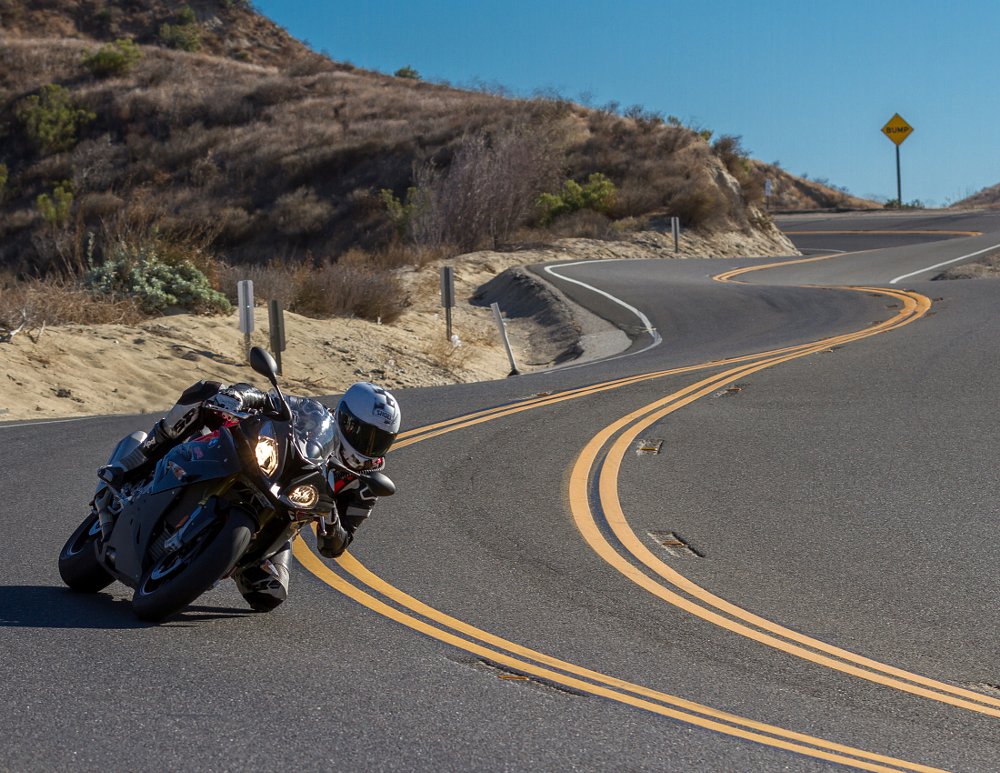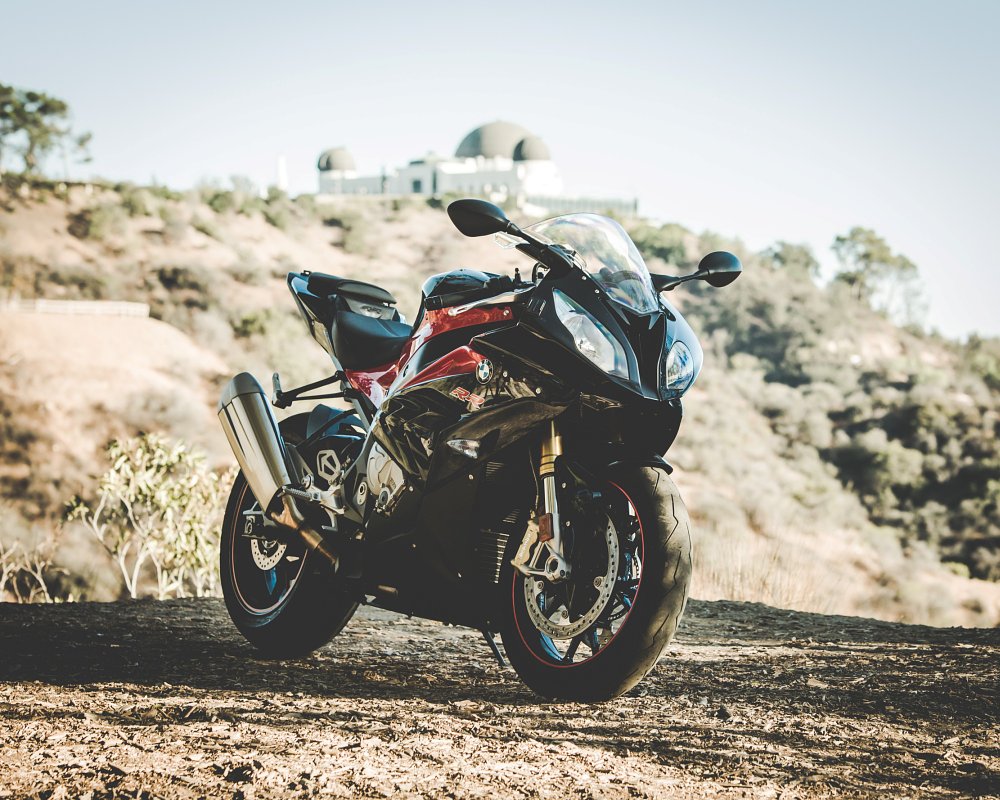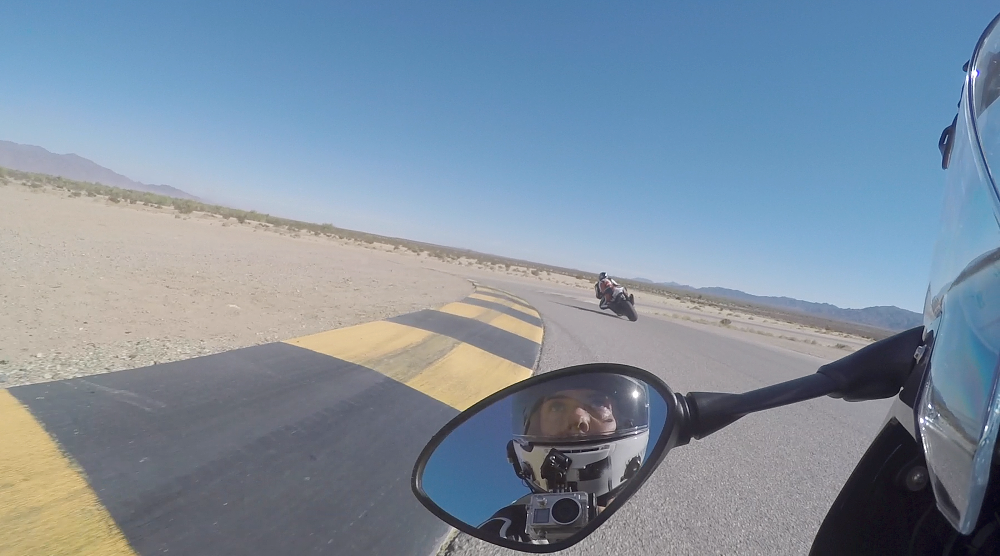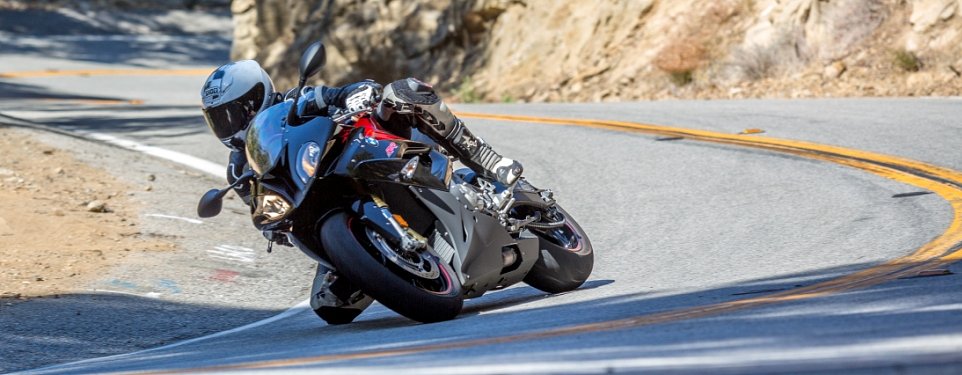I’ve been waiting two years to get my hands on this one.
Ever since the latest generation of BMW’s S 1000 RR was unleashed in 2015, my friend at BMW corporate has been campaigning for me to throw a leg over one. My personal ride is a 2012 S 1000 RR and he promised I would love the improvements of the newer electronics package. He also wanted to see what I could do in terms of wrangling the Bavarian beast’s power with my hybrid style of speed and bike manipulation. It took a while to make it happen, but ZLA finally lined up a play date with the land shark for two full days at the race track. I even coaxed BMW into letting me keep the bike for some “testing” on the streets for a couple of weeks.

Doing a thorough test of today’s superbikes is no small order. Heaps of horsepower, tamed by a myriad of technologies keep us mere mortals safe on the street and track. The added features, on top of ever evolving geometry and component changes, create a long list of aspects to evaluate. I definitely have my hands full with this S 1000 RR, so let’s dive in.

The bike
The S 1000 RR I tested is a 2016 model. Most of the changes for 2017 involve tweaks to the electronics.

BMW offers one model with two possible packages: Standard and Premium. The differences include forged aluminum wheels versus the standard cast aluminum, and the premium option of the Dynamic Damping Control (DDC) fork instead of the standard inverted fork. The standard option will fetch $17,690 and $19,540 for the premium package. Add $300 if you fancy the factory colors (White Light/Lupin Blue Metallic/Racing Red) scheme instead of the Black Storm Metallic/Racing Red or Racing Red/White Light options. Curb weight is now reported at 449 pounds, which is nine pounds less than the previous generation.
In 2015, BMW increased output by six horsepower by updating the cylinder head and intake system. Reported horsepower is now at 199 and peak torque was increased to 83 foot-pounds at 10,500 rpm. The S 1000 RR also received a newly designed twin-pipe exhaust, reducing back pressure. This change also increases mid-range power, which is very noticeable difference from my 2012 S 1000 RR.
Geometry changes were revised to increase agility and stability. Steering geometry was steepened by reducing rake 0.5 degrees (to 23.5 degrees) and decreasing trail 1.5 mm (to 96.5 mm). The longer wheelbase and slightly lower swingarm center complement the steeper steering angle for added front end feel and better rear traction.
Included in the premium package is BMW’s electronic suspension system, DDC. Once offered only on the now-nixed HP4 model, the system has been refined for the current generation. Offering different settings for each riding mode, DDC can also be further dialed in through the menu option for more or less damping. The menu allows for separate adjustments of compression and rebound damping at the rear (+/- 7 levels), but combines compression and rebound damping adjustments at the front.
Four-pot Brembo calipers are paired with dual 320 mm floating discs up front to get your speed in order before turns. A single-piston Brembo caliper and 220 mm disc slow the rear. BMW’s Race ABS also incorporates Bosch’s Motorcycle Stability Control (MSC), which includes cornering ABS used by several other manufacturers. Combined braking and rear wheel lift control are additional features included in BMW’s Race ABS system.
BMW has plenty of acronyms for the bike’s electronic aids: traction control (DTC), anti-lock brakes (ABS Pro), rear-wheel lift control, wheelie control, launch control, pit lane speed limiter, electronic suspension (DDC), quick shift/auto blip down shift (Shift Assist Pro). Now that I need an IPA to wet my throat (yeah, I just threw another acronym in for good measure), there’s also the long-standing riding modes that have preset parameters for most of these aids. Finally, the S 1000 RR has a couple of convenience features rare among sport bikes: heated grips and cruise control.

Testing the S 1000 RR
The bulk of my testing of the bike’s electronics, handling, power, and limits were carried out in the safe, controlled environment of Chuckwalla Valley Raceway. Let me break down the bike's performance by category, with extra attention to the electronics. Let’s face it, besides raw power numbers, when it comes to superbikes these days, the electronics are what consumers look at to separate the competitors.
Geometry and ergos
Compared to my 2012, the geometry changes on the 2016 have translated into a more nimble machine with more feeling and feedback from the front. While my previous-generation bike had decent front end feeling, it is more of a wrestling match to get the bike from side to side.
Even with OEM street tires that don’t always hook up as ideally as race tires, there was better traction at the rear exiting hard out of corners than on my personal S1KRR laced with slicks. Besides the more refined traction control intervening if needed, the geometry changes have also added more stability to the rear.

Throttle and power delivery
I am a bit envious of the power delivery of the new generation compared to my 2012. After a short time on my S 1000 RR, I stated it was a missile that only belonged at the track. The heaps of power, little to no engine braking, and long gearing just weren’t suited to my liking on the streets.
I still say the 2016 S 1000 RR is primarily a specialized track weapon, but the revisions to the power delivery have translated to a more manageable street bike. Throttle feel is lighter (less fatigue on long rides), thanks to the 100 percent electromotive throttle control. Mid-range power is better. A twitch of the throttle allows you to easily be out of harm's way of a four-wheeler merging into your lane on the streets, regardless of where you are in the rev range.

Brakes and ABS
You can never go wrong with Brembo. The one-finger braking power and lack of brake fade is always a night-and-day difference from other makes, in my experience. While it was easy to rely on hammering on the gas to get by fellow riders at the track, it was great knowing I had plenty on the binders to out-brake anyone I caught between turns.
The combination of BMW’s cornering ABS and rear wheel anti-lift features in the regular riding modes (Slick mode eliminates rear ABS) kept the bike settled and tracking straight in all of the hard-braking zones. Despite my efforts to raise the rear or even induce a back in (drift) into turns, the darn electronics won every time. I was forced to utilize Slick mode or the ABS/DTC on/off button on the left controls to have some freedom (read: greater risk).
When I missed a brake marker on the track, I nervously held my breath as I trail braked deeper into the turn than one would want to on a loaner bike. Losing the front on your own bike by over braking while leaned over is one thing. Returning a mangled press bike to the manufacturer is quite another. Luckily, BMW’s cornering ABS feature had my back. You can feel the bike undulate a bit instead of feeling the intermittent loss of traction that would make an experienced rider either lessen brake pressure or stand the bike up. Instead, I was able to keep my lean and brake pressure as the electronics did their job. No blown turn, no bike sliding across the ground. Just another nailed apex. Technology is a good thing.
Bonus features
Comfort features like cruise control and heated grips are a great touch and more evidence that the Germans like to pack everything in, even if it’s not exactly the right feature for this platform. I can only testify that the cruise control does work, but I think the only time I could see myself using it is if I were slabbing on the freeways when there actually wasn’t traffic in Los Angeles. Same goes for the heated grips. I just hope I’ll remember the bike has them on the three days a year when Southern California dips below 60 degrees or — heaven forbid — it rains. I can’t nitpick about the extra features, since they don't really hamper performance. Just make sure you're not distracted by the onboard display of your lean angles!
Clutchless shifting both up and down the gearbox on the S 1000 RR brings a smile to my unshaven mug every time. Not only does it keep the bike’s suspension smoother and give me one less mechanical task (grabbing the lever), but the mean gargle emitted from the exhaust also makes me feel like I am riding something important. So far, the Beemer’s quick shift system is the best I’ve tested. A crisp shift will give you the intended results in millisecond timing. One word of advice to any future owners: Make sure your downshifts are clean. If you try to bang down three gears without fully lifting your foot off the lever, you will probably only get one, maybe two gears. There’s no room for sloppiness with a machine designed with this much precision.
Riding modes
BMW has three modes tuned more for the street (yes, this applies to the public track… er, canyons) in “Rain,” “Sport” and “Race.” Here you still have a fun, yet safe amount of electronics to keep you riding like Jorge Lorenzo, smooth as butter. The Pro riding mode, “Slick,” minimizes ABS and greatly limits the other electronic rider aids, like traction and wheelie control. You even have the ability to further adjust traction control up or down seven steps in either direction. With Slick mode, you can take it the track, break the rear loose, wheelie down the straight, and get your Marc Márquez on.
The other Pro riding mode, “User,” is a fully customizable (through the menu) option. It lets you tailor each electronic aspect to one of the four modes. You can have the nanny election of Rain mode’s traction control paired with Slick’s almost non-existent ABS. The owner’s manual has a thorough breakdown of what each feature’s intervention would entail to help you make a more educated choice when configuring User mode. While I can’t see this feature being used on the street in lieu of the three default modes, I can see a rider using this mode at the track during mixed conditions, when you may want the safer Rain mode in the corners and softer DDC settings to keep things smooth, but the full power of the other modes on the straight.

Street usability
Even though I expressed my opinion that the S 1000 RR is a specialized track weapon, the reality is that both you and I will ride this machine on the streets. Do I think this precision-driven bike is suitable for the streets? Yes. It’s very obvious that BMW implemented features specifically for public road usage (ABS, heated grips, cruise control, etc). I found myself looking for any reason to ride the RR the two extra weeks I had it sitting in my garage. Splitting traffic, long hauls to the kid’s soccer matches, grab some ingredients for dinner, and the ever favorite canyon carving were all executed with a smile on my face. If you’re comparing the RR to other liter bikes for primary street usage, you may find that the creature comforts lean in the BMW’s favor.
BMW S 1000 RR highlights
Nitpicking aside, there’s very very little to be found wanting in this bike. The current platform of the S 1000 RR is so much better than my previous-gen bike, I would happily trade my missile for the new model, if BMW is willing.
I’m a huge fan of the new power curve. It’s much more linear now. My 2012 really struggles in tight, twisty canyons. I’ve been really apprehensive about shortening my gearing to compensate, due to the fear of too much power to the rear too quickly. The 2016 S 1000 RR is happy no matter where it’s running in the rev range. No more bogging feel coming out of slow corners.
While the handling characteristics of the S1KRR can’t hold a light to that of the Yamaha YZF-R1 or Aprilia RSV4, I’m very happy with the improvements from mine. Transitioning from side to side is lighter, thanks to the geometry changes and frame revisions. At the end of two days at the track, I wasn’t left with the blistered palms I have from one day at the track with my Beemer.
One session was enough to build trust in the DDC suspension. The system does a great job of silently working while you concentrate on hitting your marks. I never felt like I had to come into the pits to make an adjustment to the DDC settings because the bike tracked through the turn whether I was coming in too hot or abruptly transitioning to throttle out.
The electronics are as good as everyone says, but it would be nice to have an independent wheelie control adjustment, ideally in Slick mode. I’m also hoping that BMW will make it possible to make DDC adjustments on the fly, instead of having to be in the pits to navigate through the menu to find the setting adjustment. We now have that ability with traction control in the Pro riding modes.

BMW S 1000 RR lowlights
If I had an audience with the design engineers, I’d simply show a picture of Yamaha’s TFT cluster and walk away. With all of BMW’s electronic advancements, I find it hard to understand why they wouldn’t keep up with aesthetics and rider usability. The S 1000 RR cluster and menu isn’t counterintuitive or anything. It's just not as easy as the R1’s… or as pretty.
Maybe I’m too quick to swap out stock setups for aftermarket rearsets to remember what stock shift levers are like. I am a big fan of the race (reverse) shift pattern, and to get that I usually have to upgrade at least the shifter from stock. BMW allows for race shifting by simply mounting the linkage to an already existing mounting tab on the lever, and that’s great! My biggest gripe, however, is that the lever itself offers no rubber padding for your foot. If you roll around town in your favorite Jordans, you’ll probably have a slight hitch in your giddy up walking around after the ride.
The bike runs hot! Not in an overheating sense, but with the heat exiting from the engine, your legs and baby-making area may be screaming for wind and speed while commuting in rush hour traffic. Flowing on the track or twisties it didn’t seem to be an issue, though.
Lastly, pay attention to your fairing bolts. The S1KRR doesn’t have the vibey idle of a twin, but for whatever reason, the fairing bolts seem to wriggle their way out over time. Most commonly the mid fairing bolt that threads into the frame. This happens with my personal Beemer, as it did with the 2016 model. Luckily, that specific bolt is longer, and will stick out enough to be obvious before it is offered to the road gods.
The competition
Though 2016 is about to become a fading object in our mirrors, there are still plenty of reasons to grab a 2016 model. Only Honda and Suzuki have completely redesigned their liter bikes, while the others have added features or offer rich men’s GP version race replicas (Ducati 1299 Superleggera, Honda RC213V-S, Aprilia RSV4 GP). Factory incentives and dealer closeouts can really change up pricing dynamics, but for now, here is a quick chop up.
The most important aspect for me is the cornering ABS (besides trying to argue horsepower figures, and electronics packages), because safety on the streets is paramount. Ducati, Kawasaki, Yamaha, and BMW offer it on their 2016 models. The other makes are implementing cornering ABS for 2017.
The handling of the BMW is better than the previous generation, but I still think the R1 wins in flickability. Honda may be second, but we all know the CBR lacks in horsepower.
The S 1000 RR is right next to the Kawi as least expensive for the base models that offer cornering ABS. When factoring in the lesser equipped models like the GSX-R and CBR, BMW’s pricing falls right in the middle. Furthermore, if you want to class BMW into the “European exotics,” it is more affordable than the Aprilia and Ducati.

Conclusion
There’s an ongoing joke within my riding crew that everyone is on a BMW these days. There’s truth to that, and for good reason. German engineering is German engineering. There’s not much to fault in BMW’s electronics. Pricing is exceptional, too, considering the features you get and compared to the competition.
This BMW was my first test bike with on-the-go suspension adjustments and cornering ABS. I quickly learned the value of both in real-world and track conditions. The BMW provides a smooth ride when rolling down the highway and then lets me brake hard or dive into a corner with instantly adjusted damping. This reduces fatigue and improves handling. I am thoroughly pleased with the S 1000 RR combining rocket power with safety and handling.
Now I just have to figure out how I can send my 2012 back to BMW and keep this 2016 without the fleet manager noticing.
| 2016 BMW S 1000 RR | |
|---|---|
| Price | $17,960 |
| Displacement | 999 cc |
| Bore x Stroke | 80 mm x 49.7 mm |
| Power | 199 horsepower @ 13,500 rpm |
| Torque | 83 foot-pounds @ 10,500 rpm |
| Compression ratio | 13:1 |
| Front suspension | Inverted 46 mm fork |
| Rear suspension | Aluminum double-strut swingarm with central spring strut |
| Wheelbase | 56.1 in |
| Front brake | Twin floating 320 mm discs, four-piston fixed calipers |
| Rear brake | Single 220 mm disc, single-piston floating caliper, BMW Race ABS |
| Front tire | 120/70ZR17 |
| Rear tire | 190/55ZR17 |
| Seat height | 32.1 inches |
| Weight | 449.8 pounds wet |
| Fuel capacity | 4.7 gallons |












